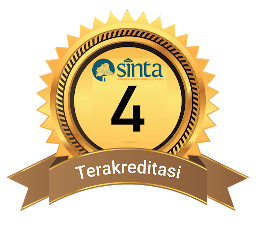Blended Learning on the Material Reaction Rate and It’s Impact on Learning Outcomes
DOI:
10.29303/cep.v7i1.4754Published:
2024-05-31Issue:
Vol. 7 No. 1 (2024): Edisi Mei 2024Keywords:
Blended Learning, learning outcomes, class XIArticles
Downloads
How to Cite
Abstract
This research aims to determine the effect of learning outcomes of class XI IPA students at SMA Negeri 2 Mataram by using blended learning on the subject matter of reaction rates. An understanding of abstract chemical concepts requires appropriate learning strategies so that in the learning process students do not feel bored. The use of blended learning by paying attention to students initial abilities is thought to be able to overcome this problem. This type of research is a quasi-experimental research. The research data used a learning achievement test which consisted of 13 multiple choice questions accompanied by reasons. The results showed that the average learning outcomes of students who were taught using blended learning were higher then those who were taught using conventional learning. Data analysis used a One-way Ancova statistical test, and after being tested, the results showed that blended learning did not have a significant effect on the chemistry learning outcomes of class XI IPA students at SMA Negeri 2 Mataram.
References
Amin, Ahmad Kholiqul. (2017). Kajian Konseptual Model Pembelajaran Blended Learning Berbasis Web untuk Meningkatkan Hasil Belajar dan Motivasai Belajar. Jurnal Pendidikan Edutama. 4(2): 51-64.
Astuti, Puji & Febrian. (2019). Blended Learning Syarah: Bagaimana Penerapan dan Persepsi Mahasiswa. Jurnal Gantang. 4(2): 111-119.
Darmawan, Wiratama., Kuswandi, Dedi & Praherdhiono, Henry. (2020). Pengaruh Blended Learning Berbasis Flipped Classroom pada Mata Pelajaran Prakarya terhadap Hasil Belajar Siswa Kelas X SMK. Jurnal Kajian Teknologi Pendidikan. 5(1): 170-179.
Fakhrurrazi. (2018). Hakikat Pembelajaran yang Efektif. Jurnal At-Tafkir. 11(1): 85-99.
Febriani, Hanifa & Azizah, Utiya. (2021). Metode Blended Learning Berbantuan Google Classroom Meningkatkan Kemandirian Belajar Siswa. Jurnal Pendidikan Kimia Indonesia. 5(1): 9-15.
Hadi, Sutarto & Kasum, Maidatina Umi. (2015). Pemahaman Konsep Matematika Siswa SMP Melalui Penerapan Model Pembelajaran Kooperatif Tipe Memeriksa Berpasangan (Pair Checks). Jurnal Pendidikan
Matematika. 3(1): 59-66.
Irfan, M. (2019). Pengaruh Penerapan Metode Resitasi terhadap Hasil Belajar Kognitif Siswa SMA. Bioma. 1(1): 47-55.
Magdalena, Maria. (2018). Kesenjangan Pendekatan Model Pembelajaran Konvensional dengan Model Pembelajaran Kontekstual terhadap Hasil Belajar Pancasila di Program Studi Teknika Akademi Maritim Indonesia-Medan. Jurnal Warta. 1(1): 1-19.
Napitupulu, Dedi Sahputra. (2019). Proses Pembelajaran Melalui Interaksi Edukatif dalam Pendidikan Islam. Jurnal Tazkiya. 8(1): 125-138.
Nugroho, Deni Ebit & Prayitno, Mohammad Agus. (2021). Analisis Miskonsepsi Peserta Didik dalam Memahami Konsep dengan Menggunakan Tes Diagnostik TTMC. Jurnal Education and Development. 9(1): 72-76.
Nurrita, Teni. (2018). Pengembangan Media Pembelajaran untuk Meningkatkan Hasil Belajar Siswa. Misykat. 3(1): 171-187.
Pangondian, Roman Andriato., Santosa, Paulus Insap & Nugroho, Eko. (2019). Faktor-Faktor yang Mempengaruhi Kesuksesan Pembelajaran Daring dalam Revolusi Industri 4.0. Proceedings of Seminar Nasional Teknologi Komputer & Sains, Yogyakarta: Januari 2019. Hal. 56-60.
Pradana, Diemas Bagas Panca. (2017). Pengaruh Penerapan Tools Google Classroom pada Model Pembelajaran Project Based Learning terhadap Hasil Belajar Siswa. Jurnal IT-Edu. 2(1): 59-67.
Putri, Gesa Kharisma & Dewi, Yuli Ani Setyo. (2019). Pengaruh Model Pembelajaran Jarak Jauh Berbasis Google Classroom. Al-Fikrah. 2(1): 60-79.
Ristiyani, Erika & Bahriah, Evi Sapinatul. (2016). Analisis Kesulitan Belajar Kimia di SMAN X Kota Tangerang Selatan. Jurnal Penelitian dan Pembelajaran IPA. 2 (1): 18-29.
Sandi, Gede. (2012). Pengaruh Blended Learning terhadap Hasil Belajar Kimia Ditinjau dari Kemandirian Siswa. Jurnal Pendidikan dan Pengajaran. 45(3): 241-251.
Zulqarnain., Al-Faruq, M. Shoffa Saifillah & Sukatin. (2021). Psikologi Pendidikan. Yogyakarta: CV Budi Utama.
Author Biographies
Azizah Aulyah, Universitas Mataram
Agus Abhi Purwoko, Program Studi Pendidikan Kimia, Universitas Mataram. Mataram, Indonesia
Supriadi Supriadi, Program Studi Pendidikan Kimia, Universitas Mataram. Mataram, Indonesia
License
Copyright (c) 2024 Azizah Aulyah, Agus Abhi Purwoko, Supriadi Supriadi

This work is licensed under a Creative Commons Attribution-ShareAlike 4.0 International License.
Authors who publish with Chemistry Education Practice agree to the following terms:
- Authors retain copyright and grant the journal right of first publication with the work simultaneously licensed under a Creative Commons Attribution License 4.0 International License (CC-BY-SA License). This license allows authors to use all articles, data sets, graphics, and appendices in data mining applications, search engines, web sites, blogs, and other platforms by providing an appropriate reference. The journal allows the author(s) to hold the copyright without restrictions and will retain publishing rights without restrictions.
- Authors are able to enter into separate, additional contractual arrangements for the non-exclusive distribution of the journal's published version of the work (e.g., post it to an institutional repository or publish it in a book), with an acknowledgement of its initial publication in Chemistry Education Practice.
- Authors are permitted and encouraged to post their work online (e.g., in institutional repositories or on their website) prior to and during the submission process, as it can lead to productive exchanges, as well as earlier and greater citation of published work (See The Effect of Open Access).






